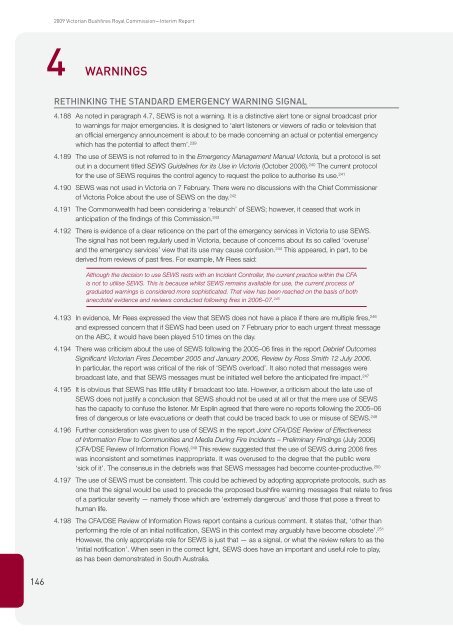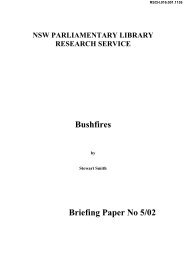Chapter 4 - Warnings - 2009 Victorian Bushfires Royal Commission
Chapter 4 - Warnings - 2009 Victorian Bushfires Royal Commission
Chapter 4 - Warnings - 2009 Victorian Bushfires Royal Commission
Create successful ePaper yourself
Turn your PDF publications into a flip-book with our unique Google optimized e-Paper software.
<strong>2009</strong> <strong>Victorian</strong> <strong>Bushfires</strong> <strong>Royal</strong> <strong>Commission</strong>—Interim Report<br />
4 WARNINGS<br />
RETHINKING THE Standard emergency warning signal<br />
4.188 As noted in paragraph 4.7, SEWS is not a warning. It is a distinctive alert tone or signal broadcast prior<br />
to warnings for major emergencies. It is designed to ‘alert listeners or viewers of radio or television that<br />
an official emergency announcement is about to be made concerning an actual or potential emergency<br />
which has the potential to affect them’. 239<br />
4.189 The use of SEWS is not referred to in the Emergency Management Manual Victoria, but a protocol is set<br />
out in a document titled SEWS Guidelines for its Use in Victoria (October 2006). 240 The current protocol<br />
for the use of SEWS requires the control agency to request the police to authorise its use. 241<br />
4.190 SEWS was not used in Victoria on 7 February. There were no discussions with the Chief <strong>Commission</strong>er<br />
of Victoria Police about the use of SEWS on the day. 242<br />
4.191 The Commonwealth had been considering a ‘relaunch’ of SEWS; however, it ceased that work in<br />
anticipation of the findings of this <strong>Commission</strong>. 243<br />
4.192 There is evidence of a clear reticence on the part of the emergency services in Victoria to use SEWS.<br />
The signal has not been regularly used in Victoria, because of concerns about its so called ‘overuse’<br />
and the emergency services’ view that its use may cause confusion. 244 This appeared, in part, to be<br />
derived from reviews of past fires. For example, Mr Rees said:<br />
Although the decision to use SEWS rests with an Incident Controller, the current practice within the CFA<br />
is not to utilise SEWS. This is because whilst SEWS remains available for use, the current process of<br />
graduated warnings is considered more sophisticated. That view has been reached on the basis of both<br />
anecdotal evidence and reviews conducted following fires in 2006–07. 245<br />
246<br />
4.193 In evidence, Mr Rees expressed the view that SEWS does not have a place if there are multiple fires,<br />
and expressed concern that if SEWS had been used on 7 February prior to each urgent threat message<br />
on the ABC, it would have been played 510 times on the day.<br />
4.194 There was criticism about the use of SEWS following the 2005–06 fires in the report Debrief Outcomes<br />
Significant <strong>Victorian</strong> Fires December 2005 and January 2006, Review by Ross Smith 12 July 2006.<br />
In particular, the report was critical of the risk of ‘SEWS overload’. It also noted that messages were<br />
broadcast late, and that SEWS messages must be initiated well before the anticipated fire impact. 247<br />
4.195 It is obvious that SEWS has little utility if broadcast too late. However, a criticism about the late use of<br />
SEWS does not justify a conclusion that SEWS should not be used at all or that the mere use of SEWS<br />
has the capacity to confuse the listener. Mr Esplin agreed that there were no reports following the 2005–06<br />
fires of dangerous or late evacuations or death that could be traced back to use or misuse of SEWS. 248<br />
4.196 Further consideration was given to use of SEWS in the report Joint CFA/DSE Review of Effectiveness<br />
of Information Flow to Communities and Media During Fire Incidents – Preliminary Findings (July 2006)<br />
(CFA/DSE Review of Information Flows). 249 This review suggested that the use of SEWS during 2006 fires<br />
was inconsistent and sometimes inappropriate. It was overused to the degree that the public were<br />
‘sick of it’. The consensus in the debriefs was that SEWS messages had become counter-productive. 250<br />
4.197 The use of SEWS must be consistent. This could be achieved by adopting appropriate protocols, such as<br />
one that the signal would be used to precede the proposed bushfire warning messages that relate to fires<br />
of a particular severity — namely those which are ‘extremely dangerous’ and those that pose a threat to<br />
human life.<br />
4.198 The CFA/DSE Review of Information Flows report contains a curious comment. It states that, ‘other than<br />
performing the role of an initial notification, SEWS in this context may arguably have become obsolete’. 251<br />
However, the only appropriate role for SEWS is just that — as a signal, or what the review refers to as the<br />
‘initial notification’. When seen in the correct light, SEWS does have an important and useful role to play,<br />
as has been demonstrated in South Australia.<br />
146
















